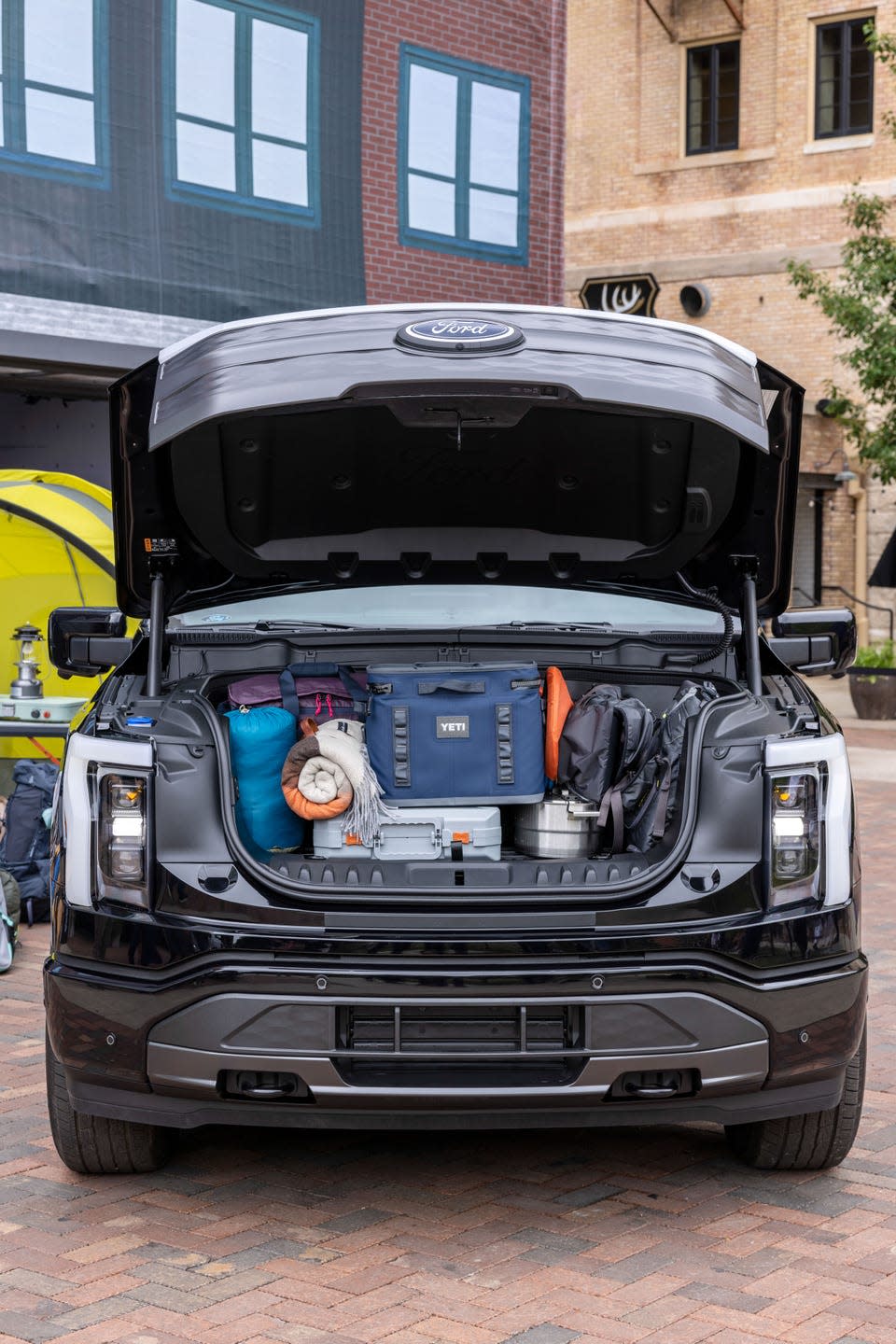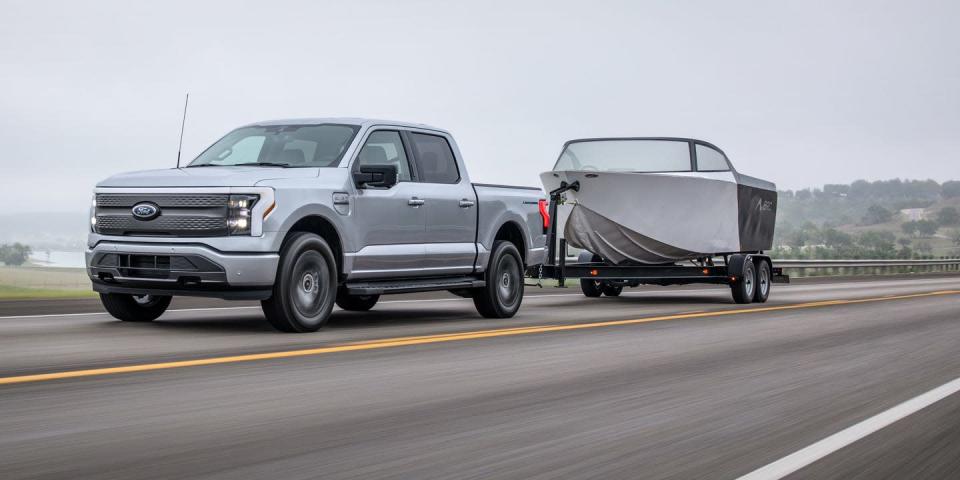
Henry Ford was an employee of and friend to electricity pioneer Thomas Edison, so it shouldn’t be much of a shock that in the early days of his car company, he developed an electric car. The EV never made it to production in large part because the bestselling Model T was just that. Today, the Ford F-series is America’s current sales champ, and Ford has chosen to leverage that brand with its first electric pickup, the F-150 Lightning.
This is the third F-150 to wear a Lightning badge. The first two were performance pickups and to a certain degree, this version is, too. With either 452 horsepower with the standard-range battery or 580 horsepower with the extended-range battery, this is the most powerful F-150 by a minimum of two ponies (at least until the Raptor R drops in a few months). It also happens to be the heaviest, but a curb weight starting at some 6400 pounds isn’t enough mass to make this Lightning even remotely slow—we expect the hi-po version to reach 60 mph in about 4.5 seconds. That’s quick enough to dethrone the current Raptor as the quickest F-150, but Ford will need a Lightning R to challenge the Rivian R1T for EV-pickup-acceleration supremacy. (We have yet to test a GMC Hummer EV.)
Naming this F-150 “Lightning” isn’t as egregious of a sin as the Mustang Mach-E, a name many of those with blue-oval blood cells consider sacrilegious. Buyers will recognize it as an F-150. But underneath it is closer to Mach-e GT than to any other F-150. All Lightnings get two motors, one on each axle, and a big battery between the frame rails of a modified F-150 chassis, with the biggest mod being the trailing arms that give the Lightning an independent rear suspension. The body is all but identical stamped and welded aluminum. The Lightning gets a closed-off grille with just a small opening for some heat exchangers, a sculpted hood, a flat and armored floorpan, and different taillights.

Thought this truck has many parlor tricks—a big frunk that can swallow 400 pounds, an optional tongue-weight scale, and BlueCruise hands-free driving—none are as impressive as how quick it builds speed from a standstill, thanks to 775 pound-feet of instant torque. Mat the accelerator and the front tires spin. Actually, the fronts will spin if you floor the accelerator at any speed below 50 mph or so. The effect is amplified as you load the truck closer to its 2235-pound max payload capacity.
It even drives and feels a lot like an F-150. A 50/50 weight balance contributes to very good road manners. Head toss is kept to a minimum when unloaded, and all but disappears if you put 1000 pounds in the bed. Although, with conventional coil springs and dampers, the ride can’t quite compete with the adaptive hardware we’ve come to expect on pickups at this price point. No one buys a pickup because it steers well, and the Lightning doesn’t raise that bar, but it motors down the road with aplomb. A low center of gravity keeps the truck relatively flat through corners, too.

The base vinyl-lined Pro model starts at $41,769 and comes with the 98.0-kWh battery that’s good for an EPA range of 230 miles, while the upgraded extended-range battery brings 131.0 kilowatts-hours of storage and 320 miles of range. The bigger battery is a $10,000 line item no matter the trim, but only fleet customers can spec it to the Pro line. In the next-step-up XLT, selecting the extended-range battery also requires an additional $9500 312A equipment package, which includes otherwise high-dollar options such as Pro Power Onboard (9.6-kW worth of power outlets in the bed and frunk), power seats, a power tailgate, as well as a heated steering wheel and heated seats. So, the average Ford customer who wants 320 miles of range is looking at a minimum of $74,269 for a cloth-interior XLT. An extended-range Lariat, with leather, hands-free BlueCruise, and a massive sunroof, is $5000 more. The top-spec Platinum comes in at $92,669, but those have only a 300-mile EPA range due in part to the 22-inch wheels (18s and 20s underpi
n other models) and a curb weight flirting with 7000 pounds.
The extended-range battery also includes Ford’s Charge Station Pro, an otherwise $1310 accessory that serves as a charging and energy off-boarding connection for your home. You have to pay an electrician to install it (or you should), and to get the Ford Intelligent Backup Power function that can power your home in the event of a utility outage, you also have to pay for and install the $3895 Home Integration System. Bottom line, if you want your Lightning to be a home-generator proxy, it’ll cost you.
Another key practicality component to the extended-range battery is a more powerful onboard charger: 19.2 kilowatts to the standard battery’s 11.3. This results in a level 2, 80-amp charging time (from 15 to 100 percent) reduction of eight hours versus 10 for the standard setup.

On the not-so-good front, the Lightning can tow up to 10,000 pounds when spec’d with the Max Trailer Tow package, but it can’t do so for very long between charges. We pulled an 8300-pound boat and trailer at about 65 mph, and the on-board trip computer indicated we were getting less than one mile per kilowatt-hour. This puts the highway range with a trailer of decent size and mass somewhere around 100 miles. That means you wouldn’t want to cover more than 80 or so miles between DC-fast-charger fill-ups because of how fast charging throttles as you near a full battery. With a 150-kW charger, Ford says the Lightning can replenish its battery from 15 to 80 percent in 44 minutes with the small battery and 41 minutes with the big battery. The Lightning isn’t overwhelmed when towing, quite the opposite in fact. It lugs a load quite well with regen and the integrated trailer-brake controller confidently slowing the rig. It’s just not very practical. We can already picture the queue filled with Lightnings pulling snowmobile trailers at the few charging stations on I-75 this winter.
Ford will no doubt sell a ton F-150 Lightnings. It claims to have more than 200,000 reservations, and a good number of those aren’t existing pickup customers. For many people who use a pickup as a daily driver, and whose idea of hauling a big load is a $400 Costco run or a foursome’s golf clubs in the 5.6-foot bed, the truck is darn near perfect. But if you currently have a pickup and you plan to use a good percentage of the Lighting’s capacity on a regular basis, you might find the current infrastructure lacking. This is no fault of Ford. The infrastructure is constantly growing and changing just like the new-vehicle marketplace. Now, don’t go slapping the Mach 1 nameplate on an electric scooter or make the next GT a return to sedans, okay Ford?

You Might Also Like






